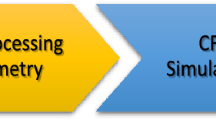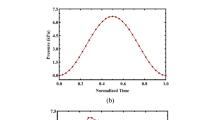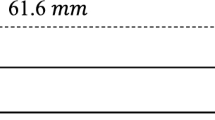Abstract
The hemodynamics of intracranial aneurysm (IA) comprise complex phenomena that influence the IA’s growth and rupture risk. It has long been argued in in silico studies of IA hemodynamics that wall compliance could be neglected, because it does not alter the hemodynamic patterns. The purpose of this work is to investigate the effect of wall compliance on IA hemodynamic patterns and flow field variables. We conducted comparative in vitro laser PIV measurements on rigid silicone and elastic PVA-H models of side-wall IA. In the first study of its kind, the interaction between wall dynamics and IA hemodynamics is investigated experimentally at high spatio-temporal resolution. It is evidently shown that wall compliance affects the phase-shift, flow rate and pressure damping, velocity and vorticity fields inside the aneurysm in space and time. Near-wall velocity field, which affects vascular endothelial cells in reality, was found to have larger oscillations in the compliant model, leading to higher turbulent kinetic energy. Wall shear stress was also affected by wall compliance, with lower time average values but larger temporal variations. These differences emphasize the importance of modeling the compliance behavior of cerebral arteries in the study of aneurysms and their treatment.
Graphic abstract










Similar content being viewed by others
References
Amili O, Schiavazzi D, Moen S et al (2018) Hemodynamics in a giant intracranial aneurysm characterized by in vitro 4D flow MRI. PLoS ONE 13:e0188323. https://doi.org/10.1371/journal.pone.0188323
Bechhoefer E, Kingsley M (2009) A review of time synchronous average algorithms. In: Annual conference on prognostics and health management society PHM 2009, pp 1–10
Blankena R, Kleinloog R, Verweij BH et al (2016) Thinner regions of intracranial aneurysm wall correlate with regions of higher wall shear stress: a 7T MRI study. Am J Neuroradiol 37:1310–1317. https://doi.org/10.3174/ajnr.A4734
Bouillot P, Brina O, Ouared R et al (2014) Multi-time-lag PIV analysis of steady and pulsatile flows in a sidewall aneurysm. Exp Fluids. https://doi.org/10.1007/s00348-014-1746-0
Bouillot P, Brina O, Ouared R et al (2016) Computational fluid dynamics with stents: quantitative comparison with particle image velocimetry for three commercial off the shelf intracranial stents. J Neurointerv Surg 8:309–315. https://doi.org/10.1136/neurintsurg-2014-011468
Chiu JJ, Chien S (2011) Effects of disturbed flow on vascular endothelium: pathophysiological basis and clinical perspectives. Physiol Rev 91:327–387. https://doi.org/10.1152/physrev.00047.2009
Chiu AHY, Wenderoth J (2013) Cerebral hyperperfusion after flow diversion of large intracranial aneurysms. J Neurointerv Surg 5:e48–e48. https://doi.org/10.1136/neurintsurg-2012-010479.rep
Chung BJ, Mut F, Putman CM et al (2018) Identification of hostile hemodynamics and geometries of cerebral aneurysms: a case-control study. Am J Neuroradiol 39:1860–1866. https://doi.org/10.3174/ajnr.A5764
Cutnell JD, Johnson KW, Young D, Stadler S (2014) Physics, 10th edn. Wiley, Hoboken
Doh DH, Kim YH, Kim SK et al (2010) Simultaneous measurement system for elastic biological wall motions and its inner flow motions—is the aneurysm for a disease or for a self-defense? In: IFMBE Proceedings. Springer, Berlin, pp 481–484. https://doi.org/10.1007/978-3-642-14515-5_123
Ferguson GG (1970) Turbulence in human intracranial saccular aneurysms. J Neurosurg 33:485–497. https://doi.org/10.3171/jns.1970.33.5.0485
Frolov SV, Sindeev SV, Liepsch D, Balasso A (2016) Experimental and CFD flow studies in an intracranial aneurysm model with Newtonian and non-Newtonian fluids. Technol Health Care 24:317–333. https://doi.org/10.3233/THC-161132
Galduróz JCF, Antunes HK, Santos RF (2007) Gender- and age-related variations in blood viscosity in normal volunteers: a study of the effects of extract of Allium sativum and Ginkgo biloba. Phytomedicine 14:447–451. https://doi.org/10.1016/j.phymed.2007.06.002
Graftieaux L, Michard M, Nathalie G (2001) Combining PIV, POD and vortex identification algorithms for the study of unsteady turbulent swirling flows. Meas Sci Technol 12:1422–1429. https://doi.org/10.1088/0957-0233/12/9/307
Gwilliam MN, Hoggard N, Capener D et al (2009) MR derived volumetric flow rate waveforms at locations within the common carotid, internal carotid, and basilar arteries. J Cereb Blood Flow Metab 29:1975–1982. https://doi.org/10.1038/jcbfm.2009.176
Jain K, Jiang J, Strother C, Mardal KA (2016a) Transitional hemodynamics in intracranial aneurysms—comparative velocity investigations with high resolution lattice Boltzmann simulations, normal resolution ANSYS simulations, and MR imaging. Med Phys 43:6186–6198. https://doi.org/10.1118/1.4964793
Jain K, Roller S, Mardal KA (2016b) Transitional flow in intracranial aneurysms—a space and time refinement study below the Kolmogorov scales using Lattice Boltzmann Method. Comput Fluids 127:36–46. https://doi.org/10.1016/j.compfluid.2015.12.011
Kamoda A, Yagi T, Sato A et al (2009) Biomedical engineering analysis of the rupture risk of cerebral aneurysms: flow comparison of three small pre-ruptured versus six large unruptured cases. IFMBE Proceedings. Springer, Berlin, pp 1600–1603. https://doi.org/10.1007/978-3-540-92841-6_397
Kosukegawa H, Mamada K, Kuroki K et al (2008) Measurements of dynamic viscoelasticity of poly (vinyl alcohol) hydrogel for the development of blood vessel biomodeling. J Fluid Sci Technol 3:533–543. https://doi.org/10.1299/jfst.3.533
Lemoult G, Shi L, Avila K et al (2016) Directed percolation phase transition to sustained turbulence in Couette flow. Nat Phys 12:254–258. https://doi.org/10.1038/nphys3675
Ma D, Dumont TM, Kosukegawa H et al (2013) High fidelity virtual stenting (HiFiVS) for intracranial aneurysm flow diversion: in vitro and in silico. Ann Biomed Eng 41:2143–2156. https://doi.org/10.1007/s10439-013-0808-4
Matsuura M, Tupin S, Ohta M (2018) Compliance effect on the flow condition in vascular in vitro experiments. In: Proceedings of the ASME 2018 international mechanical engineering congress and exposition. Biomedical and biotechnology engineering, vol 3. ASME, USA. https://doi.org/10.1115/IMECE2018-87362
McGah PM, Nerva JD, Morton RP et al (2015) In vitro validation of endovascular Doppler-derived flow rates in models of the cerebral circulation. Physiol Meas 36:2301–2317. https://doi.org/10.1088/0967-3334/36/11/2301
Mulder G, Bogaerds ACB, Rongen P, Vosse FN (2009) On automated analysis of flow patterns in cerebral aneurysms based on vortex identification. J Eng Math 64:391–401. https://doi.org/10.1007/s10665-009-9270-6
Murakami H, Inaba M, Nakamura A, Ushioda T (2002) Ipsilateral hyperperfusion after neck clipping of a giant internal carotid artery aneurysm. J Neurosurg 97:1233–1236. https://doi.org/10.3171/jns.2002.97.5.1233
Ohta M, Handa A, Iwata H et al (2004) Poly-vinyl alcohol hydrogel vascular models for in vitro aneurysm simulations: the key to low friction surfaces. Technol Heal Care 12:225–233. https://doi.org/10.3233/thc-2004-12302
Okada K, Yamaguchi R (2011) Structure of pulsatile flow in a model of elastic cerebral aneurysm. J Biorheol 25:1–7. https://doi.org/10.1007/s12573-011-0035-2
Parlea L, Fahrig R, Holdsworth DW, Lownie SP (1999) An analysis of the geometry of saccular intracranial aneurysms. Am J Neuroradiol 20:1079–1089
Rashad S, Han X, Saqr K et al (2020) Epigenetic response of endothelial cells to different wall shear stress magnitudes: a report of new mechano-miRNAs. J Cell Physiol. https://doi.org/10.1002/jcp.29436
Saqr KM, Rashad S, Tupin S et al (2019) What does computational fluid dynamics tell us about intracranial aneurysms? A meta-analysis and critical review. J Cereb Blood Flow Metab. https://doi.org/10.1177/0271678X19854640
Sheinberg DL, McCarthy DJ, Elwardany O et al (2019) Endothelial dysfunction in cerebral aneurysms. Neurosurg Focus 47:E3. https://doi.org/10.3171/2019.4.FOCUS19221
Shida S, Kosukegawa H, Ohta M (2011) Development of a methodology for adaptation of refractive index under controlling kinematic viscosity for PIV. In: Proceedings of the ASME 2011 international mechanical engineering congress and exposition. Biomedical and biotechnology engineering; nanoengineering for medicine and biology, vol 2. ASME, USA, pp 313–321. https://doi.org/10.1115/IMECE2011-64388
Shojima M, Oshima M, Takagi K et al (2004) Magnitude and role of wall shear stress on cerebral aneurysm: computational fluid dynamic study of 20 middle cerebral artery aneurysms. Stroke 35:2500–2505. https://doi.org/10.1161/01.STR.0000144648.89172.0f
Tsuji M, Ishikawa T, Ishida F et al (2017) Stagnation and complex flow in ruptured cerebral aneurysms: a possible association with hemostatic pattern. J Neurosurg 126:1566–1572. https://doi.org/10.3171/2016.3.JNS152264
Ugron Á, Paál G (2014) On the boundary conditions of cerebral aneurysm simulations. Period Polytech Mech Eng 58:37–45. https://doi.org/10.3311/PPme.7392
Valen-Sendstad K, Mardal KA, Mortensen M et al (2011) Direct numerical simulation of transitional flow in a patient-specific intracranial aneurysm. J Biomech 44:2826–2832. https://doi.org/10.1016/j.jbiomech.2011.08.015
Varble N, Trylesinski G, Xiang J et al (2017) Identification of vortex structures in a cohort of 204 intracranial aneurysms. J R Soc Interface 14:20170021. https://doi.org/10.1098/rsif.2017.0021
Varble N, Tutino VM, Yu J et al (2018) Shared and distinct rupture discriminants of small and large intracranial aneurysms. Stroke 49:856–864. https://doi.org/10.1161/STROKEAHA.117.019929
Voß S, Glaßer S, Hoffmann T et al (2016) Fluid-structure simulations of a ruptured intracranial aneurysm: constant versus patient-specific wall thickness. Comput Math Methods Med 2016:1–8. https://doi.org/10.1155/2016/9854539
Warnert EAH, Murphy K, Hall JE, Wise RG (2015) Noninvasive assessment of arterial compliance of human cerebral arteries with short inversion time arterial spin labeling. J Cereb Blood Flow Metab 35:461–468. https://doi.org/10.1038/jcbfm.2014.219
Westerhof N, Stergiopulos N, Noble MIM (2010) Snapshots of hemodynamics: an aid for clinical research and graduate education. Springer
Wieneke B, Pfeiffer K (2010) Adaptive PIV with variable interrogation window size and shape. In: 15th International Symposium on applications of laser techniques to fluid mechanics (Lisbon, Portugal, 5–8 July)
Xu L, Sugawara M, Tanaka G et al (2016) Effect of elasticity on wall shear stress inside cerebral aneurysm at anterior cerebral artery. Technol Health Care 24:349–357. https://doi.org/10.3233/THC-161135
Yagi T, Sato A, Shinke M et al (2013) Experimental insights into flow impingement in cerebral aneurysm by stereoscopic particle image velocimetry: transition from a laminar regime. J R Soc Interface 10:20121031–20121031. https://doi.org/10.1098/rsif.2012.1031
Yamaguchi R, Kotani T, Tanaka G et al (2019) Effects of elasticity on wall shear stress in patient-specific aneurysm of cerebral artery. J Flow Control Meas Vis 07:73–86. https://doi.org/10.4236/jfcmv.2019.72006
Zarrinkoob L, Ambarki K, Wåhlin A et al (2015) Blood flow distribution in cerebral arteries. J Cereb Blood Flow Metab 35:648–654. https://doi.org/10.1038/jcbfm.2014.241
Zhang Q, Meng Z, Zhang Y et al (2016) Phantom-based experimental validation of fast virtual deployment of self-expandable stents for cerebral aneurysms. Biomed Eng Online 15:125. https://doi.org/10.1186/s12938-016-0250-6
Zigunov F (2020) 2D Vortex core tracking—gamma 1—super fast. MATLAB Central File Exchange. https://www.mathworks.com/matlabcentral/fileexchange/72092-2d-vortex-core-tracking-gamma-1-super-fast. Accessed 20 Jan 2020
Acknowledgements
The authors thank Mr. M. Matsuura for his experimental assistance.
Funding
This study was supported by JSPS KAKENHI (Grant numbers JP18K18356 and JP20H04557), ImPACT program of Council for Science, Technology and Innovation (Cabinet Office, Government of Japan) and Collaborative Research Grant from the Institute of Fluid Science, Tohoku University (Grant numbers J19I001 and J20I044).
Author information
Authors and Affiliations
Corresponding author
Ethics declarations
Conflict of interest
The authors declare that they have no conflict of interest.
Additional information
Publisher's Note
Springer Nature remains neutral with regard to jurisdictional claims in published maps and institutional affiliations.
Rights and permissions
About this article
Cite this article
Tupin, S., Saqr, K.M. & Ohta, M. Effects of wall compliance on multiharmonic pulsatile flow in idealized cerebral aneurysm models: comparative PIV experiments. Exp Fluids 61, 164 (2020). https://doi.org/10.1007/s00348-020-02998-4
Received:
Revised:
Accepted:
Published:
DOI: https://doi.org/10.1007/s00348-020-02998-4




